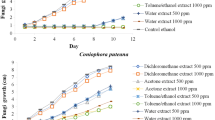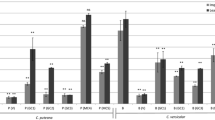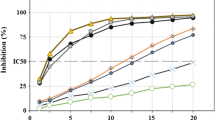Abstract
This study aims at evaluating the antifungal activity of extractive compounds obtained with fexIKA accelerate extraction process. Black locust (Robinia pseudoacacia L.) and African padauk (Pterocarpus soyauxii Taub.) heartwood as well as black locust bark were used as the source material for investigation. After grinding, extraction, impregnation and rapid durability test, the efficiency of extractive compounds was assessed by the mass loss of European beech (Fagus sylvatica L.) samples used for impregnation and as reference samples. Results showed that the extractive compounds obtained from black locust heartwood were able to increase the native durability of European beech from class 5 (i.e. not durable with an average mass loss of 43.6 %) to class 3 (i.e. moderately durable with an average mass loss of 12.7 %), rendering this study’s finding encouraging for the future use of extractive compounds as protective agents for wood.



Similar content being viewed by others
References
Baar J, Wimmer R, D´Amico S (2014) Dependence of colour and discolouration on total extractive content of African Padauk and Jatoba. Wood Sci Technol 48:1155–1165
Bergman R, Cai Z, Carll ChG, Clausen CA, Dietenberger MA, Falk RH, Frihart ChR, Glass SV, Hunt ChG, Ibach RE, Kretschmann DE, Rammer DR, Ross RJ (2010) Wood handbook—wood as an engineering material. General Tech Rep FPL-GTR-190, WI: U.S. Department of Agriculture, Forest Service, Forest Products Laboratory
Bravery AF (1979) A miniaturised wood-block test for the rapid evaluation of wood preservative fungicides. Rep. No. 136. Swed Wood Preserv Inst 21:58–65
Brémaud I, Amusant N, Minato K, Gril J, Thibaut B (2011) Effect of extractives on vibrational properties of African Padauk (Pterocarpus soyauxii Taub.). Wood Sci Technol 45:461–472
Cardon D (2007) Natural dyes: sources, tradition, technology and science. Archetype Publications 778
EN 350-2: 1994. Durability of wood and wood-based products—natural durability of solid wood: guide to natural durability and treatability of selected wood species of importance in Europe
EN 113: 1997. Wood preservatives. Test method for determining the protective effectiveness against wood destroying basidiomycetes. Determination of the toxic values
Furuno T, Imamura Y, Kajita H (2004) The modification of wood by treatment with low molecular weight phenol-formaldehyde resin: a properties enhancement with neutralized phenolic-resin and resin penetration into wood cell walls. Wood Sci Technol 37:349–361
Gérard J (1991) Gutta Percha Ironwood et Lancewood. Trois nouveaux bois précieux nord-Australiens. Un exemple de sélection technologique et de promotion d’essences secondaires tropicales (Gutta Percha, Ironwood and Lancewood. Three new precious species from North-Australia) (in French). Bois For Trop 228:63–73
Grosser D (2003) Die Hölzer Mitteleuropas (timbers of central Europe) (in German). Kessel Verlag, Remagen-Winter
Hart JH (1968) Morphological and chemical differences between sapwood, discoloured wood, and heartwood in black locust and osage orange. For Sci 14:334–338
Kartal SN, Hwang WJ, Imamura Y, Sekine Y (2006) Effect of essential oil compounds and plant extracts on decay and termite resistance of wood. Holz Roh Werkst 64:455–461
Magel E, Drouet A, Cloudot A, Ziegler H (1991) Formation of heartwood substances in the stemwood of Robinia pseudoacacia L. I. Distribution of phenylalanine ammonium-lyase and chalcone synthase across the trunk. Trees 5:203–207
Magel E, Jay-Allemand C, Ziegler H (1994) Formation of heartwood substances in the stemwood of Robinia pseudoacacia L. II. Distribution of nonstructural carbohydrates and wood extractives across the trunk. Trees 8:165–171
Mészáros E, Jakab E, Várhegyi G (2007) TG/MS, Py-GC/MS and THM-GC/MS study of the composition and thermal behavior of extractive components of Robinia pseudoacacia. J Anal Appl Pyrolysis 79:61–70
Molnar S (1995) Wood properties and utilisation of Robinia pseudoacacia L. in Hungary. Drevarsky Vyskum 1:27–33
Novriyanti E, Santosa E, Syafii W, Turjaman M, Sitepu IR (2010) Anti-fungal activity of wood extract of Aquilaria crassna Pierre ex Lecomte against agarwood-inducing fungi, Fusarium solani. J For Res 7:155–165
Nzokou P, Kamdem DP (2003) Fungal decay resistance of non-durable aspen wood treated with extractives from African padauk (Pterocarpus soyauxii). J Trop For Prod 9:125–133
Patten AM, Vassao DG, Wolcott MP, Davin LB, Lewis NG (2010) Trees: a remarkable biochemical bounty. Compr Nat Prod Chem 3:1173–1295
Richter HG (2000) Technology for high quality products from Black Locust (Robinia pseudoacacia). Project No. PL 96-4114, EU Contract Nr. ERB IC15-CT960713 238
Rodrigues AMS, Stien D, Eparvier V, Espindola LS, Beauchêne J, Amusant N, Leménager N, Baudassé Ch, Raguin L (2012) The wood preservative potential of long-lasting Amazonian wood extracts. Int Biodeterior Biodegradation 75:146–149
Royer M, Rodrigues MSA, Herbette G, Beauchêne J, Chevalier Ch, Hérault B, Thibaut B, Stien D (2012) Efficacy of Bagassa guianensis Aubl. extract against wood decay and human pathogenic fungi. Int Biodeterior Biodegradation 70:55–59
Saha JBT, Abia D, Dumarҫay S, Ndikontar MK, Gérardin P, Noaha JN, Perrin D (2013) Antioxidant activities, total phenolic contents and chemical compositions of extracts from four Cameroonian woods: Padouk (Pterocarpus soyauxii Taubb), tali (Erythrophleum suaveolens), moabi (Baillonella toxisperma), and movingui (Distemonanthus benthamianus). Ind Crop Prod 41:71–77
Scheffer TC, Morrell JJ (1998) Natural durability of wood: a worldwide checklist of species. Res Contrib 22:58
Schwanninger M, Hinterstoisser B (2002) Comparison of the classical wood extraction method using a Soxhlet apparatus with an advanced extraction method. Holz Roh Werkst 60:343–346
Sen S, Tascioglu C, Tırak K (2009) Fixation, leachability, and decay resistance of wood treated with some commercial extracts and wood preservative salts. Int Biodeterior Biodegradation 63:135–141
Singh T, Singh AP (2012) A review on natural products as wood protectant. Wood Sci Technol 46:851–870
So WT, Park SJ, Kim JK, Shim K, Lee KY, Hyun JW, Lee HS, Kang SK, Jo JM (1980) On wood properties of imported (introduced) species grown in Korea. Wood properties of Pinus stobus, Pinus silvestris, Pinus banksiana, Picea abies and Robinia pseudoacacia. Res Rep For Res Inst S Korea 27:7–31
Stringer JW (1992) Wood properties of black locust (Robinia pseudoacacia L.): physical, mechanical, quantitative chemical variability. In: Proceedings of the international conference black locust: biology, culture and utilization, 17–21 June 1991. Michigan State University, East Lansing, Michigan, pp 197–207
Surowiec I, Nowik W, Trojanowicz M (2004) Indentification of ‘insoluble’ red dyewoods by high performance liquid chromatography-photodiode array detection (HPLC-PDA) fingerprinting. J Sep Sci 27:209–216
Szyrwińska K, Lulek J (2001) Fexika extraction for the determination of selected polychlorinated biphenyl congeners in sediment samples. In: XVI-th ARS SEPARATORIA—proceedings of the XVIth international symposium on physico-chemical methods of mixtures separation. Borówno, Poland, 20–23 Jun 2001
Yang DQ (2009) Potential utilization of plant and fungal extracts for wood protection. For Prod J 59:97–103
Acknowledgments
The paper was written within grand project IGA 36/2014 “Influence of Robinia pseudoacacia L. extractive compounds on its durability and coloration”, funded by the Ministry of Education, Youth and Sports of the Czech Republic (Grant No. 6215648902) and by the European Social Fund and the state budget of the Czech Republic, project “The Establishment of an International Research Team for the Development of New Wood-based Materials” Reg. No. CZ.1.07/2.3.00/20.0269. This article was also supported by the Project CZ.1.07/2.3.00/30.0031, Postdoc contracts at MENDELU technical and economic research, with the financial contribution of EC and the state budget of the Czech Republic.
Author information
Authors and Affiliations
Corresponding author
Rights and permissions
About this article
Cite this article
Sablík, P., Giagli, K., Pařil, P. et al. Impact of extractive chemical compounds from durable wood species on fungal decay after impregnation of nondurable wood species. Eur. J. Wood Prod. 74, 231–236 (2016). https://doi.org/10.1007/s00107-015-0984-z
Received:
Published:
Issue Date:
DOI: https://doi.org/10.1007/s00107-015-0984-z




